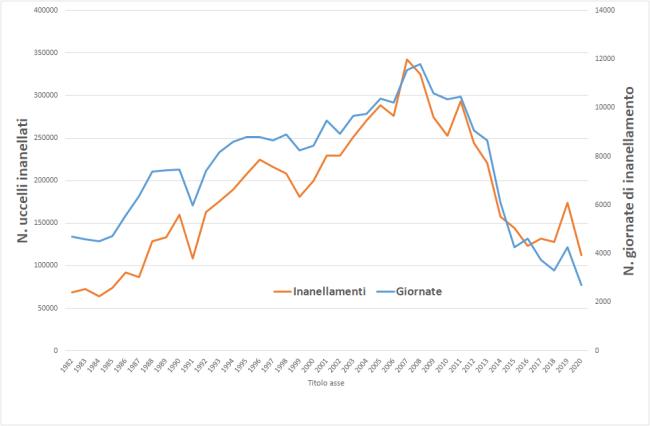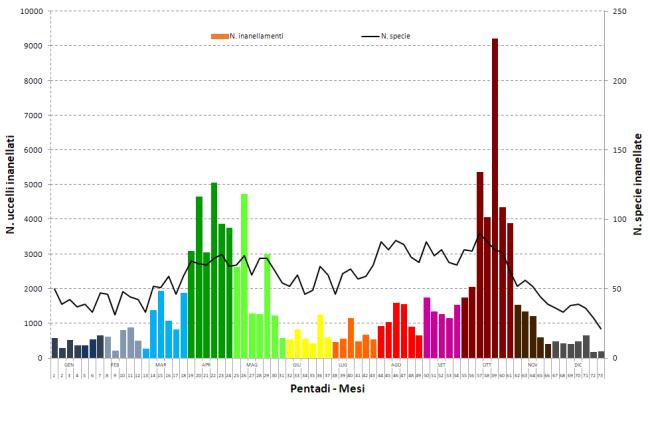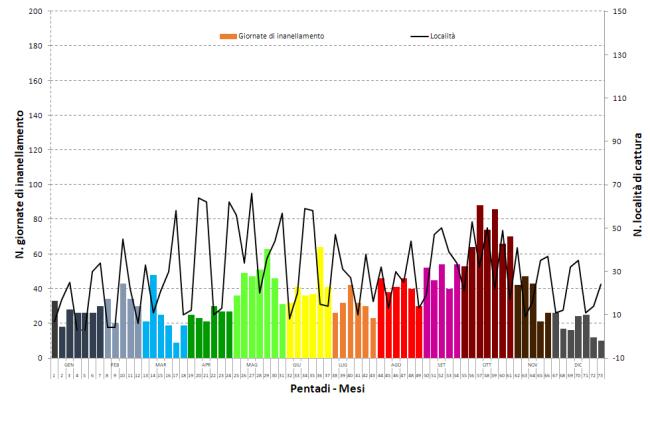Panel 1
Simona Imperio, Davide Licheri, Riccardo Nardelli, Fernando Spina
The indicator measures the abundance and diversity of bird populations in Italy throughout the year, based on bird ringing data. This assessment helps define Italy’s role in the spatial-temporal distribution of European avifauna. Data from 2019-2020 confirm Italy’s crucial importance as a major migration corridor between Europe and Africa and contribute to identifying critical periods for bird species, which is essential for conservation and management purposes.
This is a proxy indicator that evaluates bird abundance and species richness in Italy based on ringing data collected year-round. Ringing is a scientific method that allows birds—both migratory and resident—to be safely captured and individually marked.
Abundance is calculated as the total number of birds ringed during each pentad across the year at the national level. A pentad is a standardized five-day period, widely used internationally to analyse migration patterns.
Richness is assessed by summing the number of bird species recorded through ringing activities for each pentad throughout the year, at the national level.
To support both measures, sampling effort is calculated in terms of ringing locations and ringing sessions, analysed by pentad and at a national scale.
To monitor bird abundance and species richness in Italy throughout the year.
Birds Directive (2009/147/EC). Objective: to maintain bird species in a favourable conservation status.
Bonn Convention – CMS (Convention on Migratory Species of Wild Animals). Objective: to ensure a good conservation status for migratory species.
Law 157/92 – Rules for the Protection of Wild Homoeothermic Fauna and Hunting Regulations. Objective: to maintain bird species in a favourable conservation status.
Panel 2
Macchio S., Messineo A., Licheri D., Spina F., 1999 - Atlante della distribuzione geografica e stagionale degli uccelli inanellati in Italia negli anni 1980-1994. INFS, Biol. Cons. Fauna, 103.
Messineo A., Grattarola A, Spina F., 2001 - Dieci anni di Progetto Piccole isole. INFS, Biol. Cons. Fauna, 106.
Spina F., Cardinale M, Macchio S. 2001 - Biodiversità dell’avifauna italiana: variabilità morfologica nei Passeriformi (Parte I). INFS, Biol. Cons. Fauna, 107.
Messineo A., Spina F., Mantovani R., 2001 - Progetto Piccole isole : risultati 1998-1999. INFS, Biol. Cons. Fauna , 108.
ISPRA, - Rapporto Direttive Natura (2013-2018) https://www.isprambiente.gov.it/files2021/pubblicazioni/rapporti/rapporto-349_2021-direttive-natura.pdf
Licheri D. & Spina F. 2002 - Biodiversità dell’avifauna italiana: variabilità morfologica nei Passeriformi (Parte II: Alaudidae - Sylviidae). INFS, Biol. Cons. Fauna, 112.
Licheri D. & Spina F. 2003 - Biodiversità dell’avifauna italiana: variabilità morfologica nei Passeriformi (Parte III: Muscicapidae - Emberizidae). INFS, Biol. Cons. Fauna, 113.
Licheri D., Spina F., 2005 - Biodiversità dell'avifauna italiana: variabilità morfologica nei non-passeriformi. INFS, Biol. Cons. Fauna, 114.
Pedrini P., Rossi F., Rizzolli F., Spina F., 2008 - Le Alpi Italiane Quale Barriera Ecologica Nel Corso Della Migrazione Post-riproduttiva Attraverso L'Europa: Risultati Generali Della Prima Fase Del Progetto Alpi (1997-2002). INFS, Biol. Cons. Fauna, 116.
Spina F. & Volponi S., 2008 - Atlante della Migrazione degli Uccelli in Italia. Ministero dell’Ambiente e della Tutela del Territorio e del Mare, Istituto Superiore per la Protezione e la Ricerca Ambientale (ISPRA).
Nardelli R., Andreotti A., Bianchi E., Brambilla M., Brecciaroli B., Celada C., Dupré E., Gustin M., Longoni V., Pirrello S., Spina F., Volponi S., Serra L., 2015. Rapporto sull’applicazione della Direttiva 147/2009/CE in Italia: dimensione, distribuzione e trend delle popolazioni di uccelli (2008- 2012). ISPRA, Serie Rapporti, 219/2015
Ercole S., Angelini P., Carnevali L., Casella L., Giacanelli V., Grignetti A., La Mesa G., Nardelli R., Serra L., Stoch F., Tunesi L., Genovesi P. (ed.), 2021. Rapporti Direttive Natura (2013-2018). Sintesi dello stato di conservazione delle specie e degli habitat di interesse comunitario e delle azioni di contrasto alle specie esotiche di rilevanza unionale in Italia. ISPRA, Serie Rapporti 349/2021.
The network of sites where bird ringing activities are conducted is not the result of randomised and stratified sampling. Due to the voluntary nature of the ringing network, which operates under ISPRA as per Law 157/92, Art. 4§2, the sampling effort is not uniform throughout the year. This is also influenced by the seasonality of research activities, which are linked to specific projects coordinated at both national and international levels by ISPRA’s National Ringing Centre (CNI).
For these reasons, the indicator should be considered an indirect estimate of the phenomenon it aims to represent and must take sampling effort into account.
Strengthening the IT tools for querying the national database and analysing the data it contains will allow for a more robust account of the sampling effort.
A new national ringing-based ornithological monitoring programme called MonITRing was launched in 2015. This programme involves standardised sampling at over 70 ringing stations in Italy, carried out on a selected day in each 10-day period (decade) during the year. The recruitment of new ringers who will be active in the MonITRing project will lead to a further strengthening of the spatial-temporal distribution of the survey network, also on the basis of support offered locally by the competent Public Administrations.
Data quality assessment
ISPRA (Istituto Superiore per la Protezione e la Ricerca Ambientale) - National Database of Alien Species.
Bird ringing database, managed by the Bird Ringing Section of ISPRA. [http://www.epe.isprambiente.it/ , see the map viewer of the ISPRA national biodiversity network for data consultation: http://geoviewer.nnb.isprambiente.it/mapreacter/#/]
National
1982-2020
Indicator assessment
Abundance: For each year and each standardised pentad, the total number of birds ringed at all locations that provided ringing data, at the national level.
Richness: For each year and each standardised pentad, the total number of bird species recorded at all locations that provided ringing data, at the national level.
These data are presented alongside sampling effort metrics from ringers. Sampling effort is described as follows:
- For each pentad, the total number of locations where ringing activities took place at the national level.
- A further breakdown includes the total number of ringing sessions (days) conducted per pentad across all these locations.
The bird abundance and species richness index can be considered stable, although a more robust comparison can only be made with recent years, during which ringing activities have been primarily based on standardised national projects.
In 2020, the total number of ringed birds (approximately 112,000) was the lowest in the past five years, due to the reduced number of ringing days. However, the ratio of ringed birds to ringing days was the highest recorded, with an average of 42 birds per session (Figure 1).
Although the total number of ringing days has decreased over the past five years, the number of ringed species has remained stable, thanks to a better rationalisation of ringing activities.



Ringing activities, carried out by experienced technicians and volunteers under ISPRA’s national coordination, remain an crucial source of data for monitoring the relative abundance and species richness of birds in Italy throughout the year (Figure 1). These data are essential for describing Italy’s role in the spatial and temporal distribution of European birdlife and for identifying critical periods (e.g., migration, reproduction) relevant to conservation and management efforts.
The annual data for 2020, although still provisional, confirm Italy’s importance as a transit area for European birds. This is evidenced by consistently high numbers of individuals and species recorded on a pentad basis. The total number of ringed species peaks during the periods of highest migratory activity, both in the pre-breeding migration (April-May) and in the post-breeding migration (August-October) (Figure 2).
These migration phases are effectively monitored through projects coordinated by the CNI ISPRA, which operate through networks of ringing stations. Specifically:
In 2020, variations in the number of species per pentad throughout the year followed a pattern very similar to that of previous years. Minor shifts in peak pentads were observed, influenced by multiple factors, including the proportion of captured individuals per species and the varying weather conditions encountered by birds during their Mediterranean crossing.
The distribution of ringing activities in 2020 (Figure 3), in terms of both sampled locations and number of ringing days, was significantly more homogeneous throughout the year compared to previous years. This improvement was achieved through constant-effort monitoring projects (MonITRing), ensuring good coverage even in extreme weather months. This, in turn, provided better representativity of both wintering and breeding bird species within the total captures.
The rationalisation of ringing activities in recent years has led to better standardisation and, consequently, greater data comparability, enabling a more robust trend assessment. These data have contributed, among other things, to the latest National Report for the Birds Directive (2013-2018) submitted to the European Commission.
A more detailed assessment of trends and the impact of global changes on bird populations will be possible by comparing data from individual coordinated projects (Small Mediterranean Islands Project, Alps Project, MonITRing), each of which provides a key piece of the birds' life cycle puzzle.